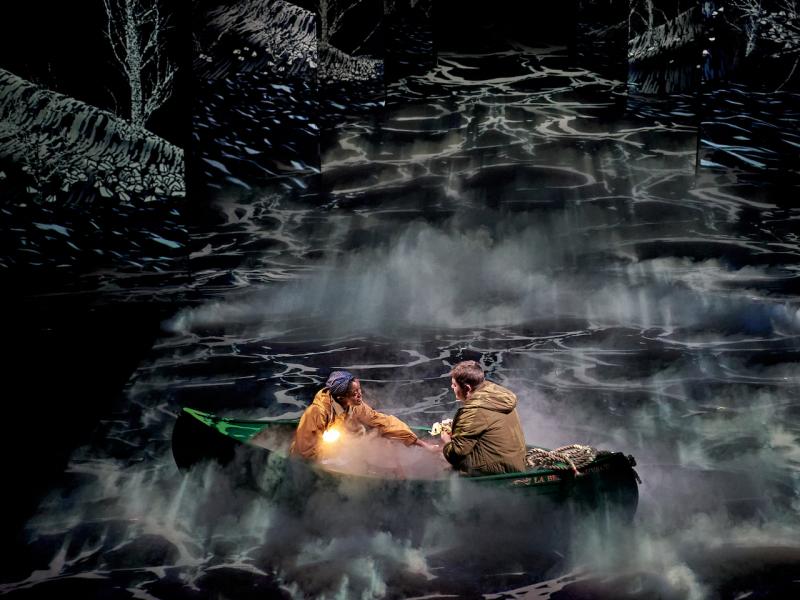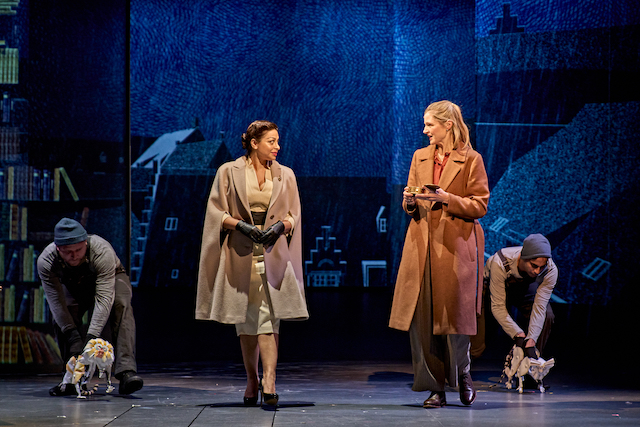The Book of Dust, Bridge Theatre review – as much intelligence and provocation as fleet-footed fun | reviews, news & interviews
The Book of Dust, Bridge Theatre review – as much intelligence and provocation as fleet-footed fun
The Book of Dust, Bridge Theatre review – as much intelligence and provocation as fleet-footed fun
The stage magic is both ingenious and beguiling

It’s been seventeen years since Nicholas Hytner first directed Philip Pullman’s His Dark Materials at the National Theatre, ambitiously whirling audiences into Pullman’s universe of daemons, damnable clerics and parallel worlds.
Samuel Creasey plays Malcolm Polstead, the bookish wide-eyed 12-year-old who becomes embroiled in forces beyond his control when he goes to visit potato-planting nuns and discovers they are concealing a baby. For the tiny minority who aren’t familiar with Pullman’s concept of the daemon as the manifestation of a person’s inner-self, we’re able to watch Malcolm’s daemon shift from mouse, to lizard to kingfisher, unable to settle as one life-form till he reaches adulthood.
Pullman has described The Book of Dust trilogy (this is an adaptation of the first book, La Belle Sauvage) as an exploration of consciousness. The fact that an individual’s daemon shifts shape until they fully mature underlines the idea that we become the kind of adult that we are through the intellectual and moral decisions that we make. Here we watch Malcolm, who has grown up in a pub, evolve as he realises that the girl baby is in danger because prophecies have foretold that she threatens the repressive church-like Magisterium. He is assisted in this by Ella Dacres’ iron-willed Alice Parslow, a fifteen-year-old with an unhappy childhood who works in his mother’s pub and, alongside her daemon, has an A-grade bullshit detector.
A huge part of the power of Pullman’s storytelling is that its many influences – not least Milton’s Paradise Lost – include quantum physics, Nordic and Greek mythology, spiced up by a withering dissection of the sexism and repression inherent in the history of the church. It’s a testament to Lavery’s adaptation that we always sense that conceptual complexity at the same time as being able to enjoy La Belle Sauvage as a fly-by-the-seat of your pants adventure. There’s no shortage of stage magic. But it’s helped by the sense of power and rigour in the words.
Though the stage magic is wonderfully beguiling in itself, not least because of Luke Halls' video design which enables Malcolm’s canoe to speed convincingly through waters that become increasingly turbulent as the action progresses. It also whisks the action through locations and seasons with projections of tangled woods and Gothic-style buildings that manage simultaneously to look real and like the best kind of book illustrations.
The outstanding puppetry in Life of Pi provides stiff competition for any puppet director in London right now. That said Barnaby Dixon’s puppet design subtly manages to evoke the life force of the characters’ different daemons through ethereal recreations of each animal with white lights that gleam like miniature souls. There’s a sense of a distinct identity established through the movement of each puppet, whether it’s in the swift yet nervous flutterings of Malcolm’s kingfisher or - most powerfully - the sinister maimed hyena that accompanies one of the story’s most repellent villains, Pip Carter’s silky-voiced Gerard Bonneville.
In proof, perhaps, that there’s no magic like old magic, one of the great show-stealing turns of the production is having the infant Lyra played by a real-life baby. The inherent unpredictability of babies inevitably means this will change the dynamic of the show each evening – but on the night I went the baby played her part to perfection, inducing gasps as she was revealed by the nuns to gaze out with wide-eyed wonder at the audience. How it will change the production when she, or indeed any other baby in the part, is screaming their head off it’s hard to know. But yesterday it felt like an inspired touch.
 It also brings added potency to a Christmas show in which a baby girl Messiah who threatens to dismantle the hypocrisy of the Church is presented as an alternative version to a baby boy Messiah who, despite preaching tolerance, managed to inspire a despotic often violent institution. One of Pullman’s great accomplishments with both his trilogies has been to take a narrative that has sidelined women for centuries by fetishising their purity and innocence, and turn it into something more complex.
It also brings added potency to a Christmas show in which a baby girl Messiah who threatens to dismantle the hypocrisy of the Church is presented as an alternative version to a baby boy Messiah who, despite preaching tolerance, managed to inspire a despotic often violent institution. One of Pullman’s great accomplishments with both his trilogies has been to take a narrative that has sidelined women for centuries by fetishising their purity and innocence, and turn it into something more complex.
The male and female leads of Hytner’s production are supported by a strong ensemble, not least Naomi Frederick as the wise female academic, Dr Hannah Relf (above right), Ayesha Dharker as a stylishly diabolical Marisa Coulter (above left) and John Light as a thundering Lord Ariel. The nuns also, played by Holly Atkins, Wendy Mae Brown and Julie Atherton, give an enjoyable sense of the irreverence that can lurk beneath a wimple.
And when the flood sweeps through the story at the end we appreciate once more the degree to which this is a narrative that richly reflects our rapidly changing world. There’s a lot of great theatre playing in London right now, but this is where to head for if you’re looking for something with as much intelligence and provocation as fleet-footed fun.
rating
Explore topics
Share this article
The future of Arts Journalism
You can stop theartsdesk.com closing!
We urgently need financing to survive. Our fundraising drive has thus far raised £49,000 but we need to reach £100,000 or we will be forced to close. Please contribute here: https://gofund.me/c3f6033d
And if you can forward this information to anyone who might assist, we’d be grateful.

Subscribe to theartsdesk.com
Thank you for continuing to read our work on theartsdesk.com. For unlimited access to every article in its entirety, including our archive of more than 15,000 pieces, we're asking for £5 per month or £40 per year. We feel it's a very good deal, and hope you do too.
To take a subscription now simply click here.
And if you're looking for that extra gift for a friend or family member, why not treat them to a theartsdesk.com gift subscription?
more Theatre
 Hedda, Orange Tree Theatre review - a monument reimagined, perhaps even improved
Scandinavian masterpiece transplanted into a London reeling from the ravages of war
Hedda, Orange Tree Theatre review - a monument reimagined, perhaps even improved
Scandinavian masterpiece transplanted into a London reeling from the ravages of war
 The Assembled Parties, Hampstead review - a rarity, a well-made play delivered straight
Witty but poignant tribute to the strength of family ties as all around disintegrates
The Assembled Parties, Hampstead review - a rarity, a well-made play delivered straight
Witty but poignant tribute to the strength of family ties as all around disintegrates
 Mary Page Marlowe, Old Vic review - a starry portrait of a splintered life
Tracy Letts's Off Broadway play makes a shimmeringly powerful London debut
Mary Page Marlowe, Old Vic review - a starry portrait of a splintered life
Tracy Letts's Off Broadway play makes a shimmeringly powerful London debut
 Little Brother, Soho Theatre review - light, bright but emotionally true
This Verity Bargate Award-winning dramedy is entertaining as well as thought provoking
Little Brother, Soho Theatre review - light, bright but emotionally true
This Verity Bargate Award-winning dramedy is entertaining as well as thought provoking
 The Unbelievers, Royal Court Theatre - grimly compelling, powerfully performed
Nick Payne's new play is amongst his best
The Unbelievers, Royal Court Theatre - grimly compelling, powerfully performed
Nick Payne's new play is amongst his best
 The Maids, Donmar Warehouse review - vibrant cast lost in a spectacular-looking fever dream
Kip Williams revises Genet, with little gained in the update except eye-popping visuals
The Maids, Donmar Warehouse review - vibrant cast lost in a spectacular-looking fever dream
Kip Williams revises Genet, with little gained in the update except eye-popping visuals
 Ragdoll, Jermyn Street Theatre review - compelling and emotionally truthful
Katherine Moar returns with a Patty Hearst-inspired follow up to her debut hit 'Farm Hall'
Ragdoll, Jermyn Street Theatre review - compelling and emotionally truthful
Katherine Moar returns with a Patty Hearst-inspired follow up to her debut hit 'Farm Hall'
 Troilus and Cressida, Globe Theatre review - a 'problem play' with added problems
Raucous and carnivalesque, but also ugly and incomprehensible
Troilus and Cressida, Globe Theatre review - a 'problem play' with added problems
Raucous and carnivalesque, but also ugly and incomprehensible
 Clarkston, Trafalgar Theatre review - two lads on a road to nowhere
Netflix star, Joe Locke, is the selling point of a production that needs one
Clarkston, Trafalgar Theatre review - two lads on a road to nowhere
Netflix star, Joe Locke, is the selling point of a production that needs one
 Ghost Stories, Peacock Theatre review - spirited staging but short on scares
Impressive spectacle saves an ageing show in an unsuitable venue
Ghost Stories, Peacock Theatre review - spirited staging but short on scares
Impressive spectacle saves an ageing show in an unsuitable venue
 Hamlet, National Theatre review - turning tragedy to comedy is no joke
Hiran Abeyeskera’s childlike prince falls flat in a mixed production
Hamlet, National Theatre review - turning tragedy to comedy is no joke
Hiran Abeyeskera’s childlike prince falls flat in a mixed production
 Rohtko, Barbican review - postmodern meditation on fake and authentic art is less than the sum of its parts
Łukasz Twarkowski's production dazzles without illuminating
Rohtko, Barbican review - postmodern meditation on fake and authentic art is less than the sum of its parts
Łukasz Twarkowski's production dazzles without illuminating

Add comment